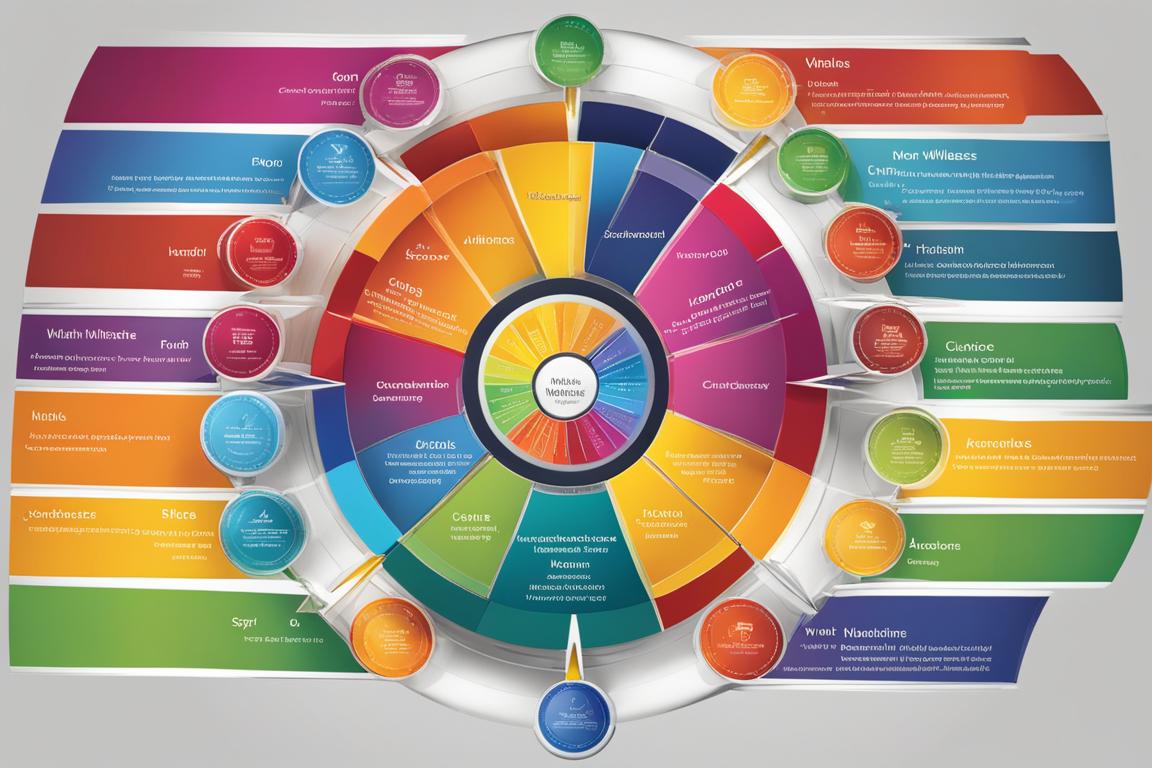Wellness wheel : Are you looking to achieve balance and well-being in all areas of your life? The wellness wheel is a powerful tool that can help you on your journey towards holistic health. By addressing each dimension of wellness, you can create a more balanced and fulfilling life.
The wellness wheel encompasses seven dimensions of well-being: physical, spiritual, intellectual, emotional, social, financial/occupational, and environmental. By evaluating and nurturing each of these aspects, you can achieve a more holistic approach to your health and well-being.
Whether you’re aiming to improve your physical fitness, find purpose and meaning in life, enhance your emotional resilience, foster meaningful relationships, or create a sustainable living environment, the wellness wheel provides a comprehensive framework to guide your actions and decisions.
Join us on a journey of self-reflection, goal setting, and active engagement as we explore each dimension of the wellness wheel and learn how to achieve balance and well-being in our lives.
Key Takeaways:
- The wellness wheel helps individuals assess their physical, spiritual, intellectual, emotional, social, financial/occupational, and environmental well-being.
- Each dimension of wellness plays a unique role in overall well-being and contributes to a balanced life.
- By addressing each dimension, individuals can create a more holistic approach to their health and well-being.
- The wellness wheel encourages individuals to assess and address the balance in each dimension to identify areas that need improvement or attention.
- By actively engaging in the wellness wheel assessment process, individuals can take ownership of their health and well-being journey.
What is the Wellness Wheel?
The wellness wheel is a powerful model developed by Dr. Bill Hettler in 1976 to promote holistic health and well-being. It provides a comprehensive framework for understanding and improving overall wellness. The wellness wheel consists of seven dimensions of wellness, each playing a vital role in achieving balance and leading a fulfilling life.
The dimensions of wellness encompass the physical, spiritual, intellectual, environmental, financial/occupational, social, and emotional aspects of an individual’s well-being. By addressing each dimension, individuals can create a more holistic approach to their health and well-being, improving their quality of life in various areas.
The physical dimension focuses on maintaining physical health through exercise, nutrition, and regular medical check-ups. The spiritual dimension emphasizes finding meaning and purpose in life through practices such as meditation and self-reflection.
The intellectual dimension encourages lifelong learning and critical thinking to enhance mental well-being. The environmental dimension highlights the importance of creating a supportive and sustainable environment through conscious choices and responsible actions.
The financial/occupational dimension promotes financial stability and career satisfaction. The social dimension emphasizes healthy relationships, effective communication, and a sense of belonging within a community. Lastly, the emotional dimension focuses on recognizing and managing emotions, cultivating resilience, and finding balance in life’s challenges.
The wellness wheel acknowledges that each dimension is interconnected and equally important for overall well-being. By addressing all dimensions, individuals can achieve balance and improve their overall health in a holistic manner. Taking steps to nurture each dimension of wellness can lead to a more fulfilling and meaningful life.
| Dimension | Description |
|---|---|
| Physical | Focuses on maintaining physical health through exercise, nutrition, and medical care. |
| Spiritual | Emphasizes finding meaning and purpose through practices such as meditation and self-reflection. |
| Intellectual | Encourages lifelong learning and critical thinking to enhance mental well-being. |
| Environmental | Highlights the importance of creating a supportive and sustainable environment through conscious choices. |
| Financial/Occupational | Promotes financial stability and satisfaction in one’s career. |
| Social | Emphasizes healthy relationships, effective communication, and a sense of belonging in a community. |
| Emotional | Focuses on recognizing and managing emotions, cultivating resilience, and finding balance. |
How Does the Wellness Wheel Work?
The wellness wheel serves as a powerful tool for achieving balance and well-being. By encouraging individuals to assess and address each dimension of their well-being, it promotes a holistic approach to health. By evaluating the level of balance in each dimension, individuals can identify areas that require improvement or attention.
This assessment is crucial in creating an action plan to enhance overall well-being and achieve a more balanced life. By recognizing areas of imbalance, individuals can focus on specific aspects of their well-being to foster improvement. Whether it be physical, spiritual, intellectual, environmental, financial/occupational, social, or emotional well-being, the wellness wheel acts as a guide in prioritizing and aligning these dimensions.
By working towards balance in each dimension, individuals can experience a more fulfilling and purposeful life. It’s important to remember that well-being is a journey, and the wellness wheel provides individuals with the tools to navigate that journey.
To better understand the concept, let’s take a closer look at each dimension of the wellness wheel and its significance in achieving holistic health:
The Physical Dimension of Wellness
Physical wellness focuses on maintaining and improving physical health through nutrition, exercise, regular medical check-ups, and responsible substance use. It encompasses taking care of the body to reduce the risk of illness and disease.
The Financial/Occupational Dimension of Wellness
Financial wellness involves living within one’s means, making informed financial decisions, and planning for the future. Occupational wellness involves finding satisfaction and fulfillment in one’s career. Achieving balance in this dimension includes balancing present-day spending with saving for the future.
The Intellectual Dimension of Wellness
Intellectual wellness encourages lifelong learning, critical thinking, and the pursuit of intellectual interests. It involves expanding knowledge and skills to stimulate the mind and contribute to personal growth.
The Emotional Dimension of Wellness
Emotional wellness entails recognizing and managing one’s emotions effectively. It involves developing emotional resilience, coping mechanisms, and the ability to adapt to change. Prioritizing emotional wellness supports overall well-being and helps individuals navigate stress and challenges in life.
The Social Dimension of Wellness
Social wellness emphasizes the importance of healthy relationships, effective communication, and a sense of belonging in a community. It involves nurturing friendships, resolving conflicts, and fostering meaningful connections with others.
The Spiritual Dimension of Wellness
Spiritual wellness focuses on finding meaning, purpose, and fulfillment in life. It involves exploring personal values, beliefs, and ethics, as well as engaging in practices such as meditation, mindfulness, and self-reflection.
The Environmental Dimension of Wellness
Environmental wellness emphasizes the impact of the environment on overall well-being. It involves creating living and working spaces that promote health and well-being, as well as being mindful of one’s impact on the environment.
By addressing and nurturing each dimension of the wellness wheel, individuals can achieve balance in their lives and experience enhanced overall well-being. Understanding the significance of each dimension and working towards balance is key to creating a more fulfilling and purposeful life.

The Physical Dimension of Wellness
The physical dimension of wellness is a crucial aspect of overall well-being. It involves taking care of your body through proper nutrition, regular exercise, and responsible medical care. Prioritizing physical wellness can significantly improve your quality of life and reduce the risk of illness and disease.
One key component of physical wellness is nutrition. A well-balanced diet that includes a variety of fruits, vegetables, whole grains, lean proteins, and healthy fats provides essential nutrients to fuel your body and support optimal health. By making wise food choices, you can maintain a healthy weight, boost your immune system, and reduce the risk of chronic conditions like heart disease and diabetes.
Regular exercise is also vital for physical wellness. Engaging in physical activities such as walking, jogging, swimming, or cycling helps strengthen your muscles, improve cardiovascular health, and increase overall fitness. Exercise not only enhances physical well-being but also promotes mental well-being by reducing stress, improving mood, and boosting cognitive function.
Another important aspect of the physical dimension of wellness is ensuring regular medical care. It involves scheduling routine check-ups with healthcare professionals, such as annual physical exams, vaccinations, and screenings. Regular medical care can help detect and prevent illnesses at an early stage, allowing for prompt intervention and treatment.
Lastly, responsible use of substances is crucial for physical wellness. Avoiding excessive consumption of alcohol, tobacco, and illicit drugs is essential for maintaining good health. Substance abuse can have severe negative effects on physical well-being and can lead to various health issues, addiction, and social problems.
By prioritizing physical wellness and taking care of your body through proper nutrition, regular exercise, and responsible medical care, you can support your overall well-being and live a healthier, happier life.
The Financial/Occupational Dimension of Wellness
The financial/occupational dimension of wellness plays a crucial role in achieving overall well-being. It encompasses two interconnected aspects: financial wellness and occupational wellness. Let’s explore how these dimensions contribute to a balanced and fulfilling life.
Financial Wellness
Financial wellness involves managing your finances in a way that promotes stability and peace of mind. It includes creating a budget, living within your means, and making informed financial decisions.
By practicing sound financial habits, such as saving for emergencies and setting financial goals, you can empower yourself to have greater control over your financial situation. This, in turn, reduces stress and allows you to focus on other areas of your life.

Occupational Wellness
Occupational wellness is all about finding fulfillment and satisfaction in your work. It involves nurturing a positive work-life balance and aligning your career with your values and interests.
When you are satisfied with your occupation, it positively impacts your overall well-being. It boosts your motivation, productivity, and sense of purpose. Additionally, finding a balance between work and personal life ensures that you have time for leisure, hobbies, and self-care.
Creating Balance
The financial/occupational dimension of wellness requires finding a balance between present-day spending and planning for the future. It is essential to strike a harmony between meeting your immediate financial needs while also saving for long-term goals.
By prioritizing both financial wellness and occupational wellness, you can create a solid foundation for your overall well-being. These dimensions contribute to your holistic health and enable you to effectively navigate the challenges and opportunities that come your way.
Key Points to Remember
- Financial wellness involves managing your finances and making informed financial decisions.
- Occupational wellness encompasses finding fulfillment and balance in your work.
- Striking a balance between present-day spending and future planning is crucial for overall well-being.
The Intellectual Dimension of Wellness
The intellectual dimension of wellness plays a vital role in enhancing overall well-being. It involves engaging in lifelong learning, exploring new skills and knowledge, and cultivating a growth mindset. By nurturing intellectual wellness, individuals can stimulate their minds and expand their understanding of the world.
One essential aspect of intellectual wellness is the pursuit of lifelong learning. This means actively seeking out opportunities to acquire new knowledge and skills, whether through formal education, online courses, workshops, or self-study. Lifelong learning allows individuals to continually challenge themselves, stay mentally sharp, and adapt to changes in their personal and professional lives.
Critical thinking is another key component of intellectual wellness. It involves analyzing information, questioning assumptions, and evaluating evidence to make informed decisions and form well-rounded opinions. By honing critical thinking skills, individuals can navigate complex situations, solve problems creatively, and discern reliable information from misinformation.
“The mind is not a vessel to be filled, but a fire to be kindled.” – Plutarch
Engaging in intellectual pursuits and critical thinking can have a profound impact on personal growth and well-being. It broadens perspectives, encourages curiosity, and fosters a deeper understanding of oneself and the world. It also promotes adaptability and resilience in the face of challenges, as individuals with strong intellectual wellness are better equipped to navigate uncertainty and find innovative solutions.
Benefits of Intellectual Wellness:
- Enhanced problem-solving and decision-making abilities
- Improved cognitive function and memory retention
- Expanded knowledge and understanding
- Cultivation of creativity and innovation
- Stimulation of personal growth and self-discovery
Embracing intellectual wellness requires a commitment to continuous learning and the development of critical thinking skills. It involves exploring diverse topics, engaging in intellectual conversations, and seeking out opportunities to challenge oneself mentally. By nurturing intellectual wellness, individuals can enrich their lives, expand their horizons, and achieve a greater sense of fulfillment and well-being.

| Ways to Cultivate Intellectual Wellness | Benefits |
|---|---|
| Read books and articles on a variety of subjects | Expands knowledge and fosters critical thinking |
| Take up a new hobby or learn a new skill | Enhances creativity and personal growth |
| Engage in intellectual discussions or join a book club | Promotes diverse perspectives and stimulates the mind |
| Enroll in online courses or attend educational workshops | Facilitates continuous learning and professional development |
| Practice critical thinking through problem-solving activities | Improves decision-making and analytical skills |
The Emotional Dimension of Wellness
The emotional dimension of wellness plays a key role in our overall well-being. It encompasses our ability to recognize and manage our emotions, develop emotional resilience, and effectively cope with stress. By nurturing our emotional wellness, we can create a foundation for a healthier and more fulfilling life.
Stress management is a crucial aspect of emotional wellness. We all experience stress in our lives, but learning how to effectively manage it is essential for our mental and physical health. By practicing stress management techniques such as exercise, deep breathing, meditation, or engaging in activities we enjoy, we can reduce the impact of stress on our well-being.
Self-expression is another vital component of emotional wellness. It allows us to authentically communicate our thoughts, feelings, and needs, leading to stronger interpersonal connections and a greater sense of self-empowerment. Finding healthy outlets for self-expression, such as through writing, art, or engaging in meaningful conversations, can be incredibly beneficial for our emotional well-being.
“Emotional wellness is not the absence of emotions, but rather the ability to understand, manage, and express them in a healthy and constructive way.”
The emotional dimension of wellness also involves developing the ability to adapt to change. Life is full of unexpected challenges and transitions, and having emotional flexibility allows us to navigate these situations with greater ease. By cultivating emotional resilience, we can bounce back from setbacks, overcome obstacles, and embrace new opportunities.
To visually represent the impact of emotional wellness on our overall well-being, consider the following table:
| Benefits of Emotional Wellness | Impact on Well-being |
|---|---|
| Improved self-awareness | Enhanced self-understanding and personal growth |
| Effective stress management | Reduced risk of stress-related health issues |
| Enhanced communication skills | Stronger relationships and connection with others |
| Increased emotional resilience | Greater ability to navigate life’s challenges |
By prioritizing emotional wellness and incorporating strategies to manage stress, express ourselves, and adapt to change, we can cultivate a positive and thriving emotional well-being. Taking care of our emotional health is an essential step towards achieving overall wellness and living a more fulfilling life.
The Social Dimension of Wellness
The social dimension of wellness plays a vital role in enhancing overall well-being. It emphasizes the importance of healthy relationships, effective communication, and a sense of belonging within a community. By nurturing social wellness, individuals can experience greater support, fulfillment, and a heightened sense of connection in their lives.
Nurturing Relationships
Building and nurturing healthy relationships is crucial for social wellness. This involves cultivating meaningful friendships, fostering trust, and investing time in personal connections. Meaningful relationships provide emotional support, companionship, and a sense of belonging, which contribute to a person’s overall well-being.
Effective Communication
Effective communication is essential for fostering healthy relationships and maintaining social wellness. It involves active listening, expressing oneself clearly and respectfully, and resolving conflicts with empathy and understanding. Good communication skills enable individuals to build stronger connections and navigate interpersonal dynamics effectively.
Good communication is the bridge that connects individuals, allowing for deeper understanding, empathy, and meaningful connections.
Fostering Community
Being part of a supportive community is essential for social wellness. Engaging in community activities, volunteering, and participating in shared interests can nurture a sense of belonging and purpose. Communities provide valuable connections, opportunities for growth, and a support system that contributes to an individual’s overall well-being.

The Spiritual Dimension of Wellness
In our quest for overall well-being, we cannot overlook the importance of the spiritual dimension. Spiritual wellness revolves around finding meaning and purpose in life, exploring our values, beliefs, and ethics, and engaging in practices that promote inner peace and self-reflection.
One powerful practice that nurtures spiritual wellness is meditation. By dedicating time to quiet the mind and cultivate mindfulness, individuals can deepen their connection to themselves and the world around them. Meditation enhances self-awareness, reduces stress, and promotes a sense of serenity and calm.
Another way to foster spiritual wellness is through the exploration of one’s purpose. Understanding our unique gifts, passions, and values allows us to align our actions with what truly matters to us. By living a life of purpose and meaning, we can experience a greater sense of fulfillment and satisfaction.
Self-reflection is also an essential component of spiritual wellness. Taking the time to reflect on our thoughts, emotions, and experiences helps us gain insights and learn valuable lessons. It enables us to deepen our understanding of ourselves, cultivate gratitude, and appreciate the beauty and interconnectedness of life.
“Spirituality is not about being perfect or having all the answers. It’s about embracing the journey of self-discovery, finding what resonates with your soul, and living in alignment with your values.”
Practicing spiritual wellness allows individuals to tap into a deeper sense of fulfillment, embrace their true selves, and establish a connection to something greater than themselves. It complements and strengthens other dimensions of wellness, contributing to a more balanced and harmonious life.
Benefits of Spiritual Wellness:
- Enhanced sense of purpose and meaning
- Reduced stress and improved mental well-being
- Increased self-awareness and self-acceptance
- Greater resilience in the face of challenges
- Deeper connection to oneself and others
How to Cultivate Spiritual Wellness:
- Practice meditation or mindfulness regularly
- Engage in self-reflection and journaling
- Explore your values, beliefs, and ethics
- Spend time in nature and appreciate its beauty
- Seek out experiences that inspire and uplift you
By nurturing our spiritual wellness and making it a priority in our lives, we can cultivate a deeper sense of purpose, find solace in the present moment, and experience a profound connection to ourselves and the world around us.

The Environmental Dimension of Wellness
The environmental dimension of wellness focuses on the impact of the environment on overall well-being, emphasizing the importance of creating living and working spaces that promote health and sustainability. By prioritizing environmental wellness, individuals can contribute to their own well-being and create a positive impact for future generations.
Living spaces play a significant role in our daily lives, affecting our physical and mental health. A well-designed and sustainable living space can enhance our well-being and provide a sense of comfort and tranquility. It is crucial to create an environment that allows for relaxation, rejuvenation, and connection with nature.
Sustainability is a key aspect of environmental wellness. By adopting sustainable practices and making conscious choices, we can minimize our carbon footprint and reduce negative impacts on the environment. This can be achieved through actions such as conserving energy, reducing waste, and using eco-friendly products.
Creating an environmentally friendly living space involves incorporating elements of nature, optimizing natural light, and utilizing eco-friendly materials and furnishings. It is important to consider the use of non-toxic and sustainable building materials, as well as energy-efficient appliances and fixtures.

Image: A sustainable living space that promotes environmental wellness
Additionally, indoor plants can improve air quality and enhance the overall aesthetic of a space. Incorporating elements such as water features, natural textures, and earthy colors can create a calming and rejuvenating atmosphere.
Moreover, outdoor spaces play a vital role in environmental wellness. Access to green spaces, parks, and natural landscapes can positively impact mental health and provide opportunities for physical activity, relaxation, and connection with nature.
Table: Benefits of Environmental Wellness
| Physical Well-being | Mental Clarity | Stress Reduction |
|---|---|---|
| Improved indoor air quality | Enhanced cognitive function | Reduced anxiety and depression |
| Access to nature for physical activity | Inspires creativity | Improved overall well-being |
| Promotes relaxation and sleep quality | Increased focus and productivity | Enhanced sense of connection with the natural world |
By prioritizing environmental wellness and creating living and working spaces that promote health and sustainability, individuals can contribute to their own well-being and the well-being of the planet. Environmental wellness is not only about taking care of the environment; it is also about creating spaces that nurture and support our own physical, mental, and emotional health.
Your Turn to Assess Your Wellness Wheel
Now it’s time for you to take charge of your well-being journey. The wellness wheel assessment is a valuable tool that allows you to evaluate your level of balance in each dimension of wellness. By identifying areas that may need attention, you can gain insights into areas of improvement and set goals for a more holistic and balanced life.
Through self-reflection, you can explore your thoughts, feelings, and experiences within each dimension. Take a moment to consider how satisfied and fulfilled you feel in your physical, financial, intellectual, emotional, social, spiritual, and environmental well-being. Honest introspection will provide you with a deeper understanding of your current state of wellness.
Once you have completed your self-reflection, it’s time to set goals. Goal setting allows you to envision where you want to be in each dimension of wellness and create a roadmap to get there. Set specific, measurable, achievable, relevant, and time-bound (SMART) goals that align with your overall vision of well-being.
“Setting goals is the first step in turning the invisible into the visible.” – Tony Robbins
Remember, goal setting is not about perfection but about progress. Start small and celebrate every milestone you achieve along the way. As you actively engage in the assessment process, you will take ownership of your health and well-being journey, paving the way for a more balanced and fulfilling life.
So grab a pen and paper, or use a digital tool, and begin your wellness wheel assessment. Take the plunge into self-reflection, goal setting, and the empowerment that comes with taking control of your well-being.

Conclusion
The wellness wheel is a powerful tool for achieving holistic health and well-being. By addressing each dimension of wellness, individuals can create balance in their lives and experience enhanced overall well-being.
Through self-reflection, goal setting, and active engagement, individuals can embark on a wellness journey that promotes personal growth, fulfillment, and a sense of purpose and meaning in life. The wellness wheel encourages individuals to assess and address their physical, spiritual, intellectual, environmental, financial/occupational, social, and emotional wellness.
By nurturing each dimension, individuals can create a more holistic approach to their health and well-being, leading to a more balanced and fulfilling life. Embracing the wellness wheel empowers individuals to take ownership of their wellness journey and cultivate a state of optimal well-being.
Also Read : Enhance Team Wellness With Effective Strategies
FAQ
Q: What is the wellness wheel?
A: The wellness wheel is a tool that describes the integration of eight dimensions of wellness, which include physical, social, emotional, environmental, and other important dimensions of wellness.
Q: What are the eight dimensions of wellness?
A: The eight dimensions of wellness are physical, social, emotional, environmental, occupational, intellectual, spiritual, and financial. Each dimension is interconnected and equally important for overall well-being.
Q: How can I balance my life using the wellness wheel?
A: By focusing on all 8 dimensions of wellness, you can start developing an action plan to address areas of wellness you thrive in and those areas that need greater attention. It’s a good way to start identifying aspects of your life that require more support and nurturing.
Q: Why is the wellness wheel important for overall well-being?
A: The wellness wheel helps individuals identify areas of wellness where they may need to devote greater attention, thus leading to a sense of balance and well-being. It is a lifelong process of making and nurturing healthy choices in all aspects of your life.
Q: How can the wellness wheel contribute to my mental health?
A: Focusing on the eight dimensions of wellness can also help in improving mental health and well-being. It provides a holistic approach to support your mental well-being by addressing various aspects of your life.
Q: What is a wellness journey?
A: A wellness journey refers to the process of proactively seeking to improve and maintain a sense of well-being in all areas of your life. It involves identifying your core health values and striving to thrive in those areas through the wellness model.
Q: How can I use the wellness wheel to create a balanced lifestyle?
A: By utilizing the wellness wheel, you can start by identifying the areas of wellness you thrive in and those areas that need greater attention. This can help you develop a personalized plan to achieve balance in all facets of your life.
Q: Can the wellness wheel be used in environmental wellness?
A: Yes, the wellness wheel can be applied to environmental wellness by recognizing the impact of our surroundings on overall well-being. It helps in identifying areas where one can improve their environmental wellness, such as through sustainable practices and creating a healthy living space.
Q: How does the wellness wheel contribute to social wellness?
A: The wellness wheel contributes to social wellness by emphasizing the importance of building and maintaining strong, supportive relationships. It prompts individuals to nurture their social connections, enabling greater social well-being.
Q: Why should I focus on all eight dimensions of wellness?
A: Focusing on all eight dimensions of wellness allows for a comprehensive approach to health and well-being. It addresses various aspects of your life and promotes a balanced, holistic well-being that encompasses both immediate and long-term benefits.





